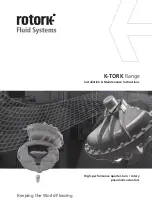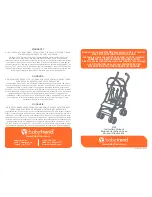
4
Introduction
1
INTRODUCTION
1.1
Purpose of this manual
This manual is produced to enable a competent user to store,
install, operate, adjust, inspect, maintain, dismantle and
dispose the Rotork K-TORK range bare actuators, where “XX”
means all the different sizes.
Work safety implies the observance of all the safety warnings
and instructions contained herein.
All Rotork actuators are tested prior to dispatch.
Up-to-date general information on Rotork products is
available on our website www.rotork.com.
Rotork reserves the right to modify, amend and improve this
manual without notice.
Warning: Prior to installing or using the actuator, the
installer or user must read and follow out the whole
manual. For any questions contact Rotork.
Rotork is not responsible for damage or injury caused by the
failure to observe the instructions contained herein.
1.2 Symbols
In this manual, warning indications are represented by icons,
according to ISO 7010 Safety Signs.
“Danger” – texts marked by this icon contain
relevant safety information and point at dangerous
situations or aspects that could represent serious
health and safety hazards for the people concerned
Hand crush / Pinch point.
Electrocution.
“Explosion” - texts marked with this icon highlight
dangerous situations or aspects where an explosion
could verify.
Substances toxic for the environment (terrestrial or
aquatic) or which could have harmful, long-term
effects.
1.3 Preservation
This manual is considered an integral part of the actuator
and must be kept along with it until the actuator is
decommissioned.
This manual and all the attached documentation are to
be preserved, kept in a suitable and accessible place and
available at all times to the maintenance operators for
consultation.
This manual shall always accompany the actuator, even when
the actuator is moved to another plant.
Should the manual be lost or damaged, please contact Rotork
to get a copy, providing the manual document number for
reference or download a copy from www.rotork.com.
1.4
EU Compliance / Regulations
Actuators destined for European member states have been
designed, built and tested according to the K-TORK procedure
and with the following regulations/directive:
• 2006/42/EC: Machinery Directive
• 97/23/EC: Pressure Equipment Directive (PED),
if applicable
• 94/9/EC: Directive for safety equipment and systems to
be used in potentially explosive atmospheres (ATEX)
• 2004 /108/EC: Electromagnetic Compatibility Directive,
if applicable
• EN ISO 12100: Machinery Safety Directive
• EN 13463-1: Non-electrical equipment intended for use in
potentially explosive atmospheres
• EN 1127–1: Explosive atmospheres – Explosion prevention
and protection
• EN 13463-5: Non-electrical equipment for use in
potentially explosive atmospheres
• UNI EN ISO 7010: Safety Signals
1.5
Customer service
If in need of technical assistance, please contact the Rotork.
When contacting Rotork, be prepared to specify the serial
number and the actuator model.
This information is on the nameplate located on the housing
cover – see paragraph 4.2.





































